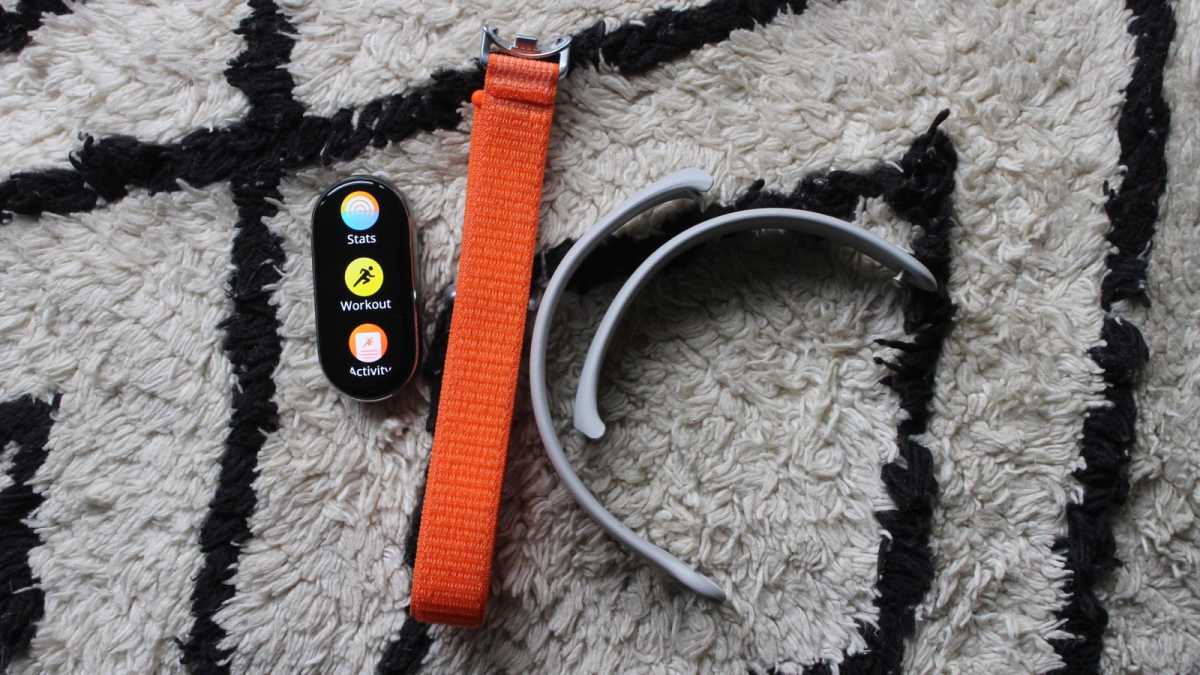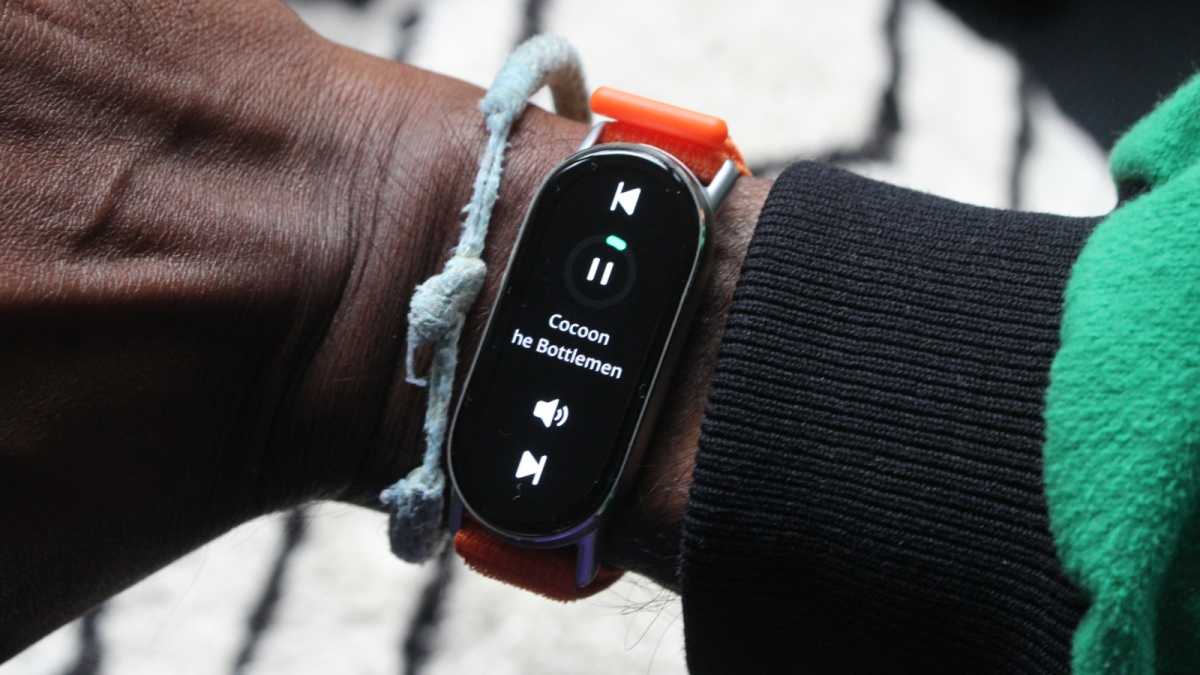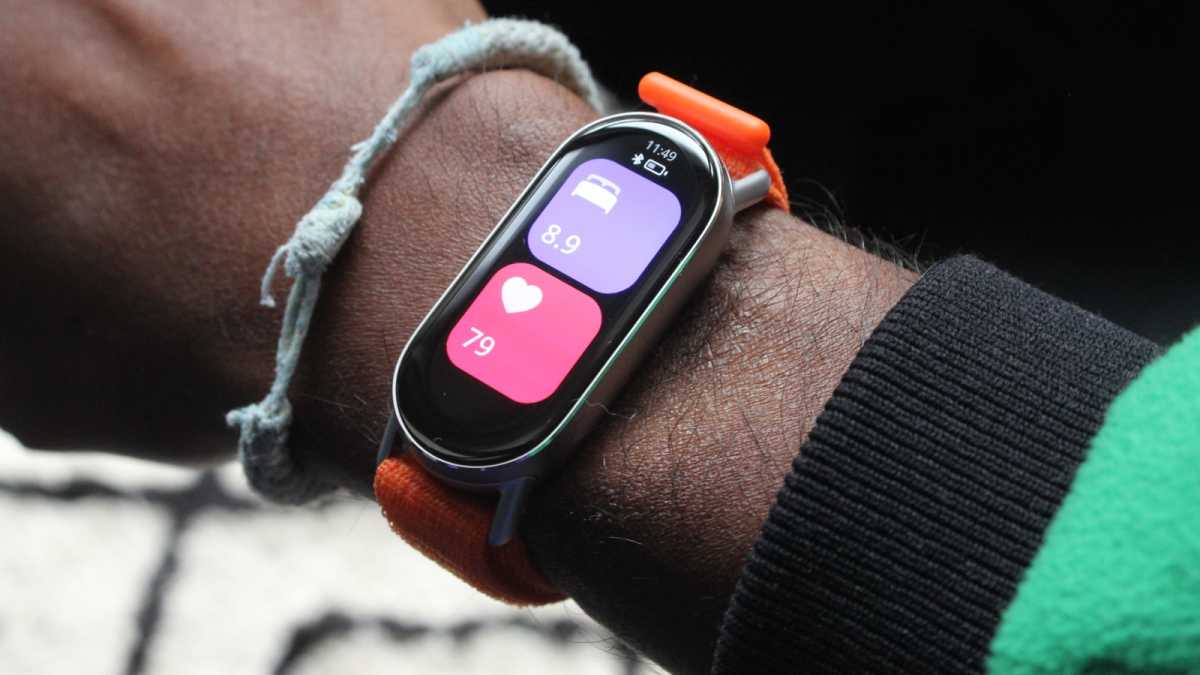Expert’s Rating
Pros
- Case and straps don’t feel budget
- Plenty of fitness features on offer
- Bright AMOLED display
Cons
- Promised improved heart rate improvements
- Still lacks built-in GPS
- Not a radical upgrade on the Smart Band 8
Our Verdict
The Xiaomi Smart Band 9 remains one of the best budget fitness trackers you can buy. It brings some nice upgrades on the Band 8 and while not perfect in all departments, covers the fitness tracking basics matched with a likeable, customisable band design.
Price When Reviewed
This value will show the geolocated pricing text for product undefined
Best Pricing Today
The Xiaomi Smart Band 9 sees the return of Xiaomi’s budget fitness tracker that, since the original Band, has continued to push the boundaries of what to expect from a cheap fitness band.
Along with offering a design that lets you wear it away from the wrist, Xiaomi now promises a brighter display, improved heart rate tracking accuracy and even bigger battery life for the same price as the Smart Band 8.
At a time when activity trackers might be comfortably outnumbered by smartwatches, Xiaomi is here for the people who really don’t want a smartwatch.
So, is this the best budget fitness tracker and one of the best overall you can buy? I’ve been wearing it for a few weeks to find out.
Design & Build
- Five strap colours
- Optional pendant and running clip
- Smaller case size
The biggest criticism of early Xiaomi Smart Band iterations was that while they came packing features you’d typically have to pay a lot more for, what those smarts were housed inside of wasn’t all that pretty.
The button-less design helps to give it a pretty pleasing streamlined look, while the TPU straps have remained securely in place with the simple button-style clasp
Xiaomi sought to improve things on the aesthetics front and things stepped up with the Band 8 with some metal and more strap options.
It’s more of the same with the Band 9, which is now available with five different strap colours. That’s your pick of blue, glacier silver (pictured), midnight black, mystic rose and titan grey.
The case still has the same gently curved to it and is made from a metal that Xiaomi doesn’t specify, but certainly looks and feels like aluminium to me. The case size has dropped from 48- to 46mm to give it a slightly smaller stature. It’s also slightly slimmer too, though not by a huge deal.
The button-less design helps to give it a pretty pleasing streamlined look, while the TPU straps have remained securely in place with the simple button-style clasp.
On the topic of straps, there are plenty of options here outside of the more exercise-friendly TPU ones that come as standard. I had one of the nylon straps to try and the button mechanism to release and replace straps is thankfully nice and easy to do.
These additional straps range from £9.99-£24.99, so it’s not a huge additional spend and along with that move to a metal case really gives Xiaomi a budget band that doesn’t feel budget at all to wear.

Mike Sawh
In addition to the straps, there’s also a pendant options to wear around your neck and a running clip like there was for the Smart Band 8 to clip onto your running shoes to get an additional hit of running data.
Xiaomi continues to offer a 5ATM waterproof rating as per the Mi Band 8, which is no huge surprise given its budget nature. It means this is still a band you can take in the water to track pool swims with profiles also available for water sports like kayaking and rowing still covered.
Screen & Audio
- Brighter AMOLED display
- Supports always-on display mode
- No microphone or speaker included
Xiaomi has always offered punchy screens that you’d associate with pricier fitness trackers and that doesn’t change with the Band 9.
It sticks to the same 1.62-inch, 192 x 480 resolution AMOLED as its predecessor, but Xiaomi has doubled the maximum brightness to 1,200 nits. It’s also made the screen better suited to use in the rain or under sweaty fingers to prevent accidentally activating the screen.
I’ve had no problems seeing glancing at it even using it with less than its maximum brightness setting

Mike Sawh
Now the Mi Band 8 didn’t exactly have a dull screen, so this just cranks things up a notch on the brightness front. I’ve had no problems seeing glancing at it even using it with less than its maximum brightness setting.
The screen quality overall is still very good, though a touch over-saturated on the colours, but whether interacting with it or simply looking at it, it’s a pretty slick operator.
Like previous global editions of the Smart Band, Xiaomi opts not to include a microphone or speaker, which is available in the NFC edition only launched in China. That NFC version has the ability to tap into Xiaomi’s Xiao assistant, so that’s what you’re mainly missing out on bar the mobile payment and transit card support.
Software & Features
- Works with Android and iOS
- Most smartwatch features available on Android and iPhone
- Nice mix of faces to pick from
The Smart Band 9 still works with iPhones and Android phones and uses Xiaomi’s Mi Fitness companion app to take care of setup, syncing and checking on your fitness and wellbeing stats.
That app thankfully isn’t a clunky affair as can often be the case with some other budget tracker companion apps and gives you the ability to sync data to Apple Health, Google Health, Strava and Suunto.

Mike Sawh
On the band, getting to grips with the software is pretty straightforward. With no physical buttons, it’s all about taps and swipes from the main watch screen.
You can swipe down to see your notification feed, which would absolutely benefit from a wider screen, but works fine enough. Swiping right gets you to the quick settings, swiping up gets you to all of the menus and modes and swiping left gets you to widgets like music controls and checking the weather.
In terms of smartwatch features, pretty much everything is available across using it with an iPhone or an Android phone.
There’s some mixed support for Android users for music controls and using it as a phone camera remote, but for things like using the find my phone mode, setting alarms and timers and using the flashlight, these are supported across platforms.
You’re not getting payments (on this version at least) or apps, but you do get a very nice collection of watch faces to pick from that really make good use of the Smart Band 9’s screen design and punchy display.

Mike Sawh
What it lacks in those big smartwatch features it makes up for in handling the basics pretty well on a slender screen and making those features mostly available across compatible phone platforms.
Fitness & Tracking
- Promised heart rate tracking accuracy improvements
- Over 150 sports modes
- No built-in GPS
Xiaomi offers a pretty impressive array of features from the same sensor array as the Smart Band 8, with the promise that the optical sensor taking care of heart rate and SpO2 tracking is 16% more accurate for all-day heart rate monitoring.
You still have to make do without built-in GPS, which seems to be reserved for Xiaomi’s Pro version of its fitness tracker, with connected GPS your way of making best use of some of the running-focused features included.
Along with core features like step, sleep, stress, heart rate and SpO2 monitoring, you’ve got your pick of over 150 different sports modes

Mike Sawh
Along with core features like step, sleep, stress, heart rate and SpO2 monitoring, you’ve got your pick of over 150 different sports modes, the ability to follow structured running sessions, get insight into your training load and VO2 Max.
As mentioned earlier, if you purchase the running clip accessory you can record advanced running metrics we’ve seen crop on up on Apple and Samsung’s smartwatches, like stride length and ground contact ratio. You can also collect Vitality points, which are related to the amount of moderate intensity exercise you manage each week.
I compared daily step counts to two other fitness trackers over my period of testing and found that daily totals tended to be within a few hundred steps of the Smart Band 9. You can set up inactivity alerts to nudge you to keep moving, while the stats screen on the band offers a nice, glanceable way to view progress.
When it was time to go to bed, I wore the Smart Band 9 alongside another wrist-based sleep tracker and a very reliable sleep tracking smart ring in the Oura Ring Gen 3 and found that it told similar stories about the time I fell asleep and woke up in the morning.
The data in between that is mixed. Light and deep sleep stages seemed to be, on average, an hour longer than the other trackers I wore. Metrics like respiration rate were similar, though resting heart rate was typically higher in comparison.
Xiaomi offers some other sleep insights that you’ll find on smartwatches, like letting you see your sleep animal after seven days of sleep data and also gain further insights into your sleep. These are very general things like what going to bed late means for your health or things that can help you feel more tired.
For a new user, these could absolutely be useful pointers if not exactly groundbreaking things to take on board.
my first workout was a pretty easy treadmill run and it matched up well to a heart rate chest strap

Mike Sawh
In terms of that promised improved heart rate accuracy, I’d say I’m unconvinced.
Resting heart rate readings were typically about 5bpm higher than two other fitness trackers I tested it against, which isn’t terrible, but also isn’t great either. Average and maximum daily readings were higher by the same number on average.
When it was time to exercise, my first workout was a pretty easy treadmill run and it matched up well to a heart rate chest strap for average and maximum readings. It was a similar story for an indoor rowing session.
For one outdoor run, the average heart rate readings were almost 10bpm out from a chest strap and 5bpm lower than the maximum heart rate recorded. It makes fitness-focused features like VO2 Max a little unreliable.
It was a similar story for the SpO2 tracking, which you need to enable initially in the app to start monitoring and seemed to drop below the typical 95-100% it normally sits in, which would indicate a potential problem and didn’t match up with other blood oxygen tracking wearables I tested it against.
When you put the connected GPS support to use for outdoor workouts, you’ll be prompted to make sure the Mi Fitness app is open and location tracking is enabled at all times to ensure it’ll work correctly. When it did it did still tend to overreport on distance.
Ultimately, if you’re looking for sports watch-grade tracking, you won’t get it here, but that’s unsurprising given the price. Perhaps Xiaomi could have ditched those sports-focused features for more activity tracking-centric ones and built on its core features.
I’d like to see Vitality points feel more a part of the tracking journey and for Xiaomi to think more ways to motivate wearers to move more on a regular basis.
Battery Life & Charging
- Larger battery
- Up to 21 days battery life
- Fully charges in one hour
Xiaomi has always talked big numbers for its trackers and while its Bands certainly can go pretty far before you’re grabbing for that proprietary charger, you need to be living a more restrictive tracking experience to do that.
The Smart Band 9 has a 233mAh capacity battery, which is up from 190mAh in the Band 8 and that sees a promise of up to 21 days battery life (up from 16 days on the Band 8).
These numbers are typically based on lab testing conditions, so aren’t always very representative of how the average Band 9 user might use it.
If you want it to go as long as 21 days, you really need to be prepared to sacrifice a lot of features.

Mike Sawh
A lot of different things have a noticeable impact on battery life. Like having the screen set to always-on or using it at maximum brightness. Enabling the most advanced sleep tracking or tracking SpO2 throughout the day. If you use the connected GPS and workout tracking on a regular basis that will impact the battery too.
I used the Smart Band 9 with a mixture of the screen set to always-on and with the raise-to-wake. I enabled notifications, tracked workouts both indoors and outdoor workouts using the connected GPS. I also had features like daily SpO2 monitoring and the most accurate continuous heart rate monitoring enabled.
I got a good week out of it with a daily drop of anywhere between 15-20%. It could be around 10% with fewer of those features mentioned.
I’d be comfortable saying this is a fitness tracker that can last a week, which is a good showing. If you want it to go as long as 21 days, you really need to be prepared to sacrifice a lot of features.
Price & Availability
The Xiaomi Smart Band 9 is now on sale for the same £34.99 price as the Smart Band 8.
You can buy it from Xiaomi as well as Amazon. It’s not officially available in the US but you can buy a ‘global version’ from Amazon for around $60.
That means it’s still one of the cheapest budget activity trackers available and comes in less than the Huawei Band 9 (£49), the Amazfit Band 7 (£60) and comes in significantly less than the cheapest Fitbit fitness tracker, the Fitbit Inspire 3, which remains at £85/$99.95.
Check out our list of the best fitness trackers for more options.
Should you buy the Xiaomi Smart Band 9?
If you want a fitness tracker that’s cheap but doesn’t look or feel cheap, has a great screen and has software that largely runs very slick, then the Xiaomi Smart Band 9 is worth picking up.
If you own a Smart Band 8, then it’s the battery gains and the boost in screen brightness that feels like the big wins here and less so the promised heart rate improvements.
The price the Smart Band 9 sits in puts it in an interesting position. You’re going to be looking at much less-known trackers competing with it, and I would not be picking those up over the Smart Band 9.
I think if you want better, more reliable day-to-day heart rate tracking, you’re going to have to pay more for something like the Fitbit Inspire 3 to get it. If you can live with a tracker that does those basics well outside of that and offers a really likeable design, then this should serve you well.
Specs
- 1.62-inch, AMOLED display
- 5 ATM water resistance rating
- Up to 21 days battery life
- Connected GPS
- Optical heart rate sensor
- Sleep and activity tracking
- 150+ sports modes















